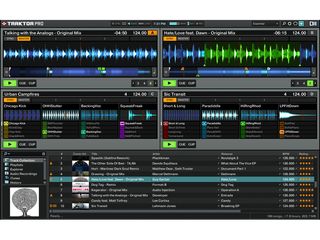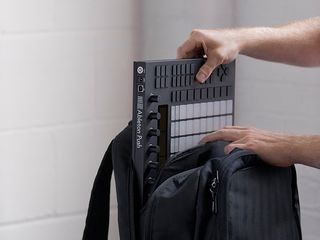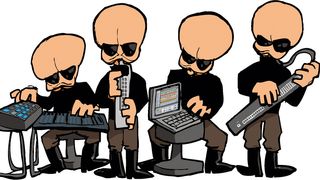In 2012, DJ/producer Deadmau5 provoked a considerable amount of debate in the electronic music world when he penned a Tumblr post entitled We all hit play.
The thrust of his argument was that most 'live' electronic dance music performances amount to doing little more than that, and the idea that artists are producing tracks on the fly while they're on stage is fanciful.
"I think given about one hour of instruction, anyone with minimal knowledge of Ableton and music tech in general could DO what I'm doing at a deadmau5 concert," he wrote, the implication being that, well, it doesn't take an enormous amount of skill.
"It's certainly true that electronic music and live performances have never been the easiest of bedfellows."
It's certainly true that electronic music and live performances have never been the easiest of bedfellows; it's just not possible to recreate every element of a highly finessed production when you're in performance mode.
But is taking a laptop on stage and hitting play really your only option? We'd argue that it isn't.
Let's first consider the art of DJing, which itself is now a pretty broad church. At one end of the aisle you have the vinyl-based scratch DJs, but if you're looking to play some of your own productions 'out' in a manner that could be considered in any way creative, the chances are that you're going to use some sort of computer.
Lust for live
Once you've got that computer, a significant number of options present themselves to you. Let's consider Native Instruments' Traktor - arguably the most popular DJing software currently on the market - which, these days, enables you to do far more than simply mix one record into another and then sprinkle a few effects over the top.
Not only does it give you four decks to work with (as opposed to the more traditional pair), but it now includes Remix Decks, which are specifically designed for live remixing and rearranging of tracks.

The basic idea is that each of the 64 slots in a deck can hold either a loop or a one-shot sample imported from your hard drive or captured from your DJ set. Thus, the concept of a linear DJ set (in which one record simply follows on from the previous one) is consigned to the past, and the line between DJing and production software becomes ever-more blurred.
Predictably enough, NI isn't the only company experimenting with technology like this. Image-Line recently released Deckadance 2, which also does some rather clever things with sampling and effects processing, and supports 4-deck operation as well.
If you want to take your existing productions out on the road to do something different with them, advanced 'DJing' apps such as these are definitely worth investigating. What's more, you'd be advised to acquire a decent multi-output audio interface as well - you don't want the crowd to hear what you're cueing up in your headphones, after all.
Taking control
An audio interface isn't the only piece of additional hardware you're likely to consider, either: for the performing electronic musician, some kind of MIDI controller or MIDI keyboard is pretty much essential.
To return to Traktor for a moment, you may have noticed that Native Instruments sells a total of five controllers that are designed specifically for use with the software - itself an indicator that it can be put to work in a variety of different ways - and that's before you even consider the juggernaut that is NI's Maschine.
Maschine, like so many of today's controllers, is based on a grid of pads. It's rare to see an EDM artist performing without at least one controller of this format - the likes of Skrillex, Flying Lotus and, yes, even the aforementioned Deadmau5, have all been spotted with pad controllers in the field. And it's hardly surprising - they're perfect for launching samples, clips and the like, particularly if you're using Ableton Live.
"It's rare to see an EDM artist performing without at least one pad controller."
Ableton Live, of course, is the very definition of a performance-friendly music production application. Indeed, many users actually 'perform' their tracks when they're arranging and jamming ideas - such is the ease with which it lets you work with and capture ideas rather than laying them out on a timeline.
However, it seems that Ableton is now adding another string to the software's bow with the new Push hardware controller.

On the surface, Push looks similar to many other pad-based devices on the market, but Ableton is actually pitching it as something rather different: a compositional platform that you can 'play' as an alternative to a traditional MIDI controller keyboard. So, you can use it to knock out melodies, chord progressions and more.
This means that it could certainly offer something a little different to the performing computer musician - you only need to head to YouTube to see that Push is already attracting its own particular brand of virtuoso.
Don't press play: play
Of course, many of us don't need Push as a keyboard alternative - we're perfectly happy with our existing black and white notes and will happily perform either alone or in a group using a laptop to generate the sounds. But even in this area there's scope for innovation: the new, ultra-expensive ROLI Seaboard is a squidgy silicon keyboard that enables you to control the pitch, volume and timbre of each note as you play it, while Eigenlabs' space-age-looking Eigenharp is designed for similarly expressive playing.
"Certain controllers position the computer-based live setup as a next-gen instrument that offers a different experience to anything else."
These controllers and others position the computer-based live setup not simply as something that can be used to recreate what's been made in the studio, but as a next-gen instrument that offers a different experience to anything else.
Finally, in this day and age it would be remiss of us not to mention the iPad, which, because of its touch screen, is practically a one-stop performance tool in itself. And with technology such as Korg's WIST, which enables you to sync the playback of supported apps on two iOS devices, it becomes an interesting option if you want to collaborate 'live' with a mate.
The options for anyone who wants to become a performing computer musician, then, are many and varied. Consider all of the technology available and how you might make it work for you. More than anything, we'd advise that if all you're currently doing is hitting play, there's plenty of scope for doing a little more than that.
This article originally appeared in issue 190 of Computer Music magazine.


